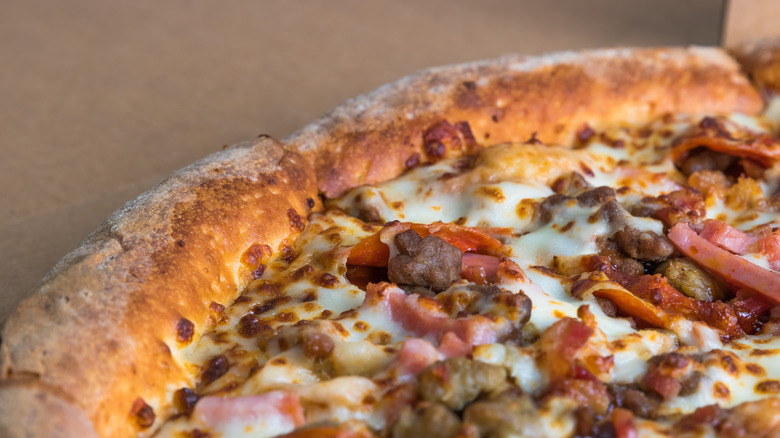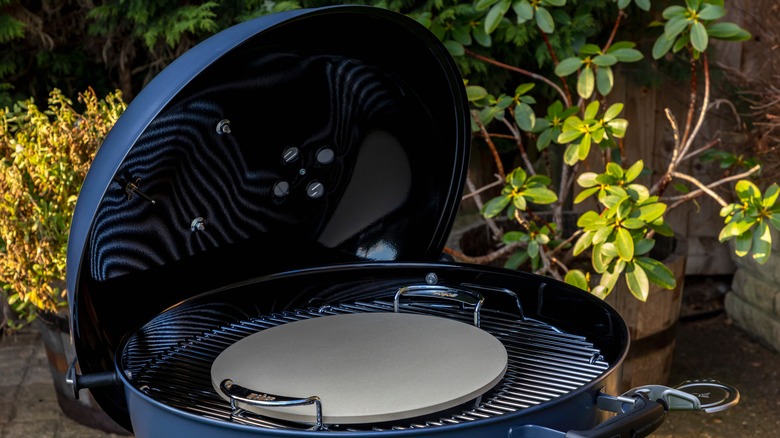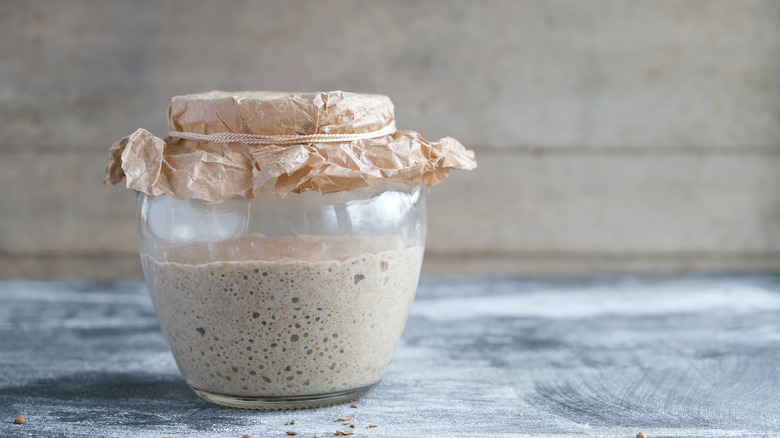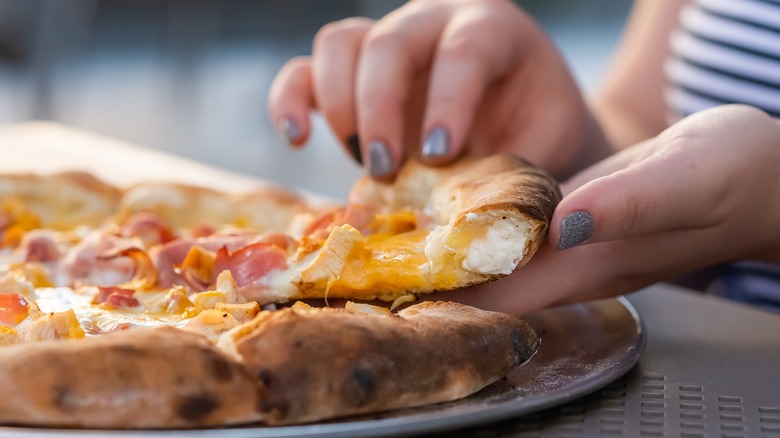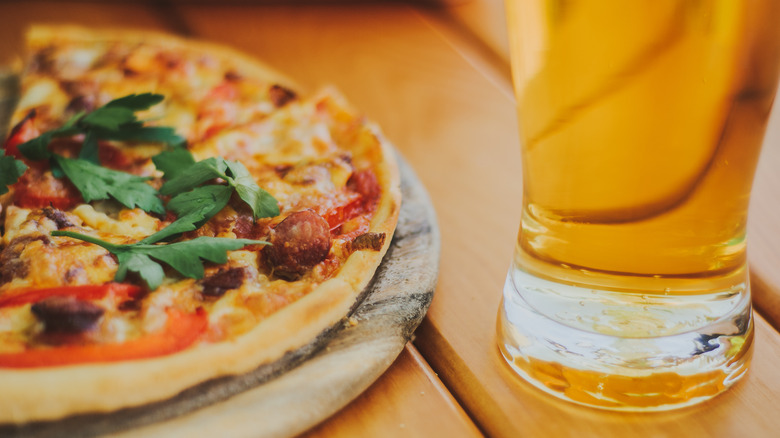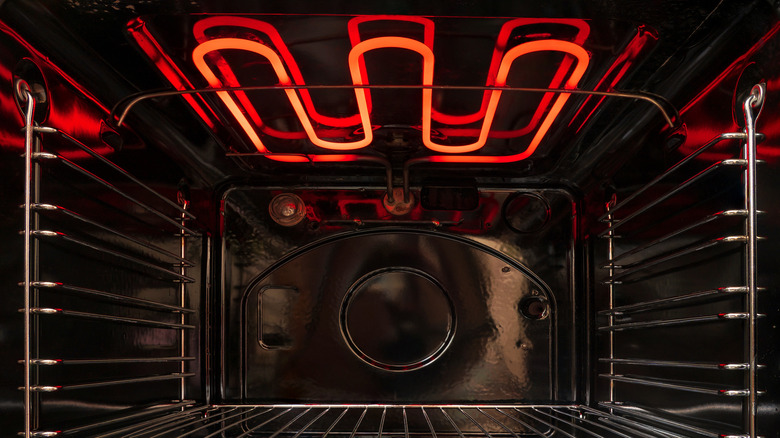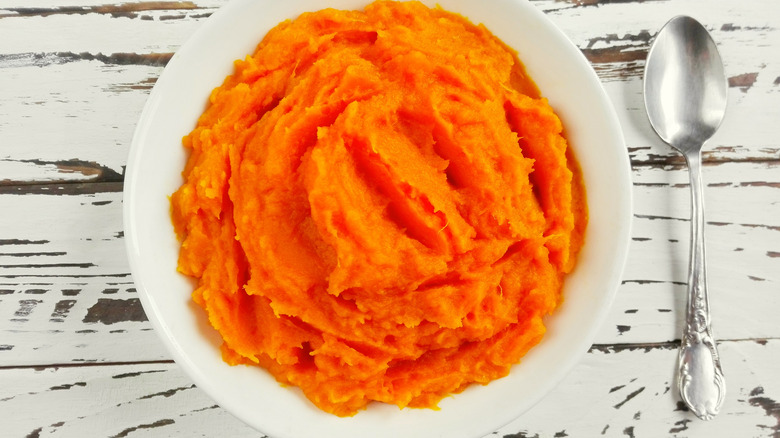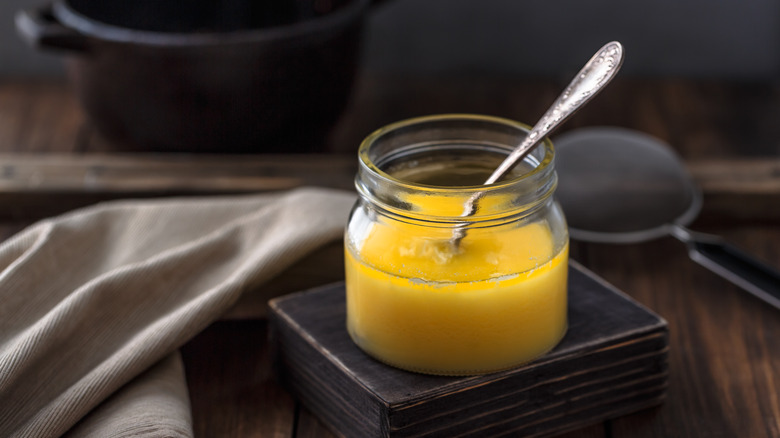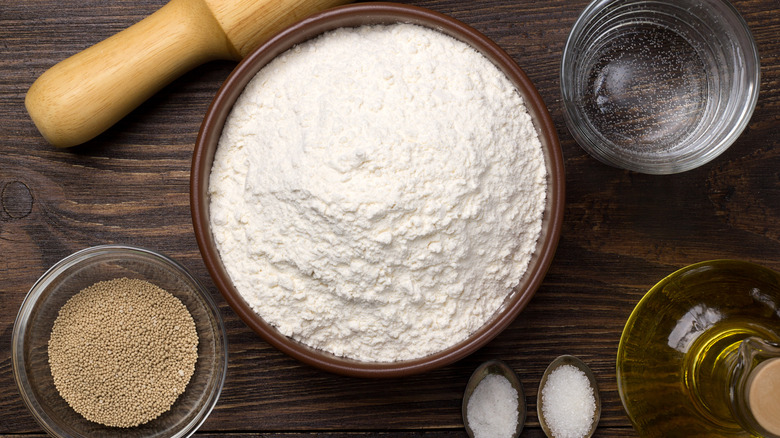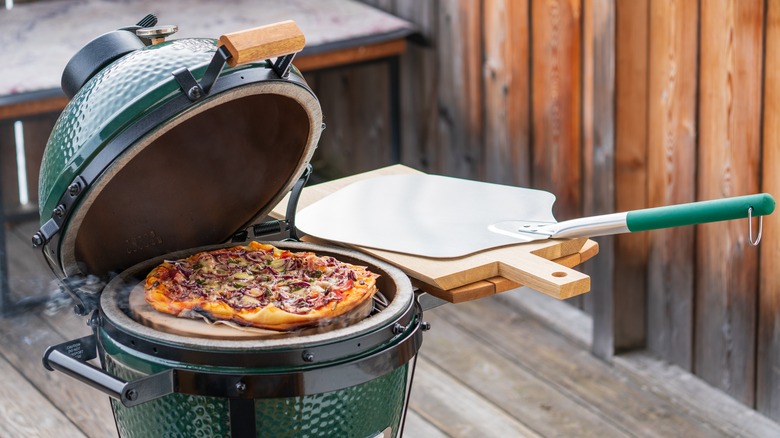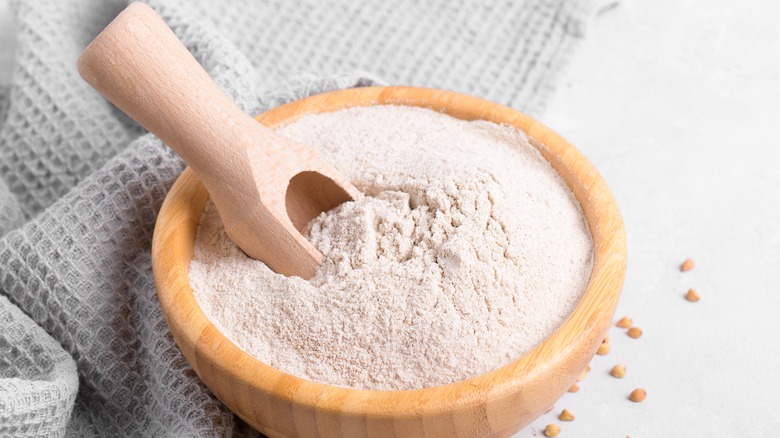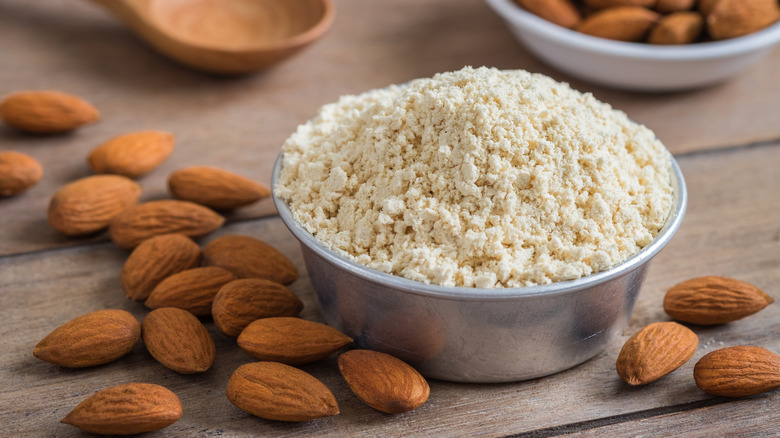12 Ways To Add More Flavor To Pizza Crust
Crust tends to get short shrift in the whole pizza conversation, relegated to being a vehicle for sauce and toppings. However, the humble baked dough can be much more than a supporting cast member when preparing a homemade pie. With some added ingredients, you can make pizza crust the star of the show.
You may already be familiar with the many out-of-the-box crust variations offered over the years at various popular pizza chains. Among the weirdest menu items in Pizza Hut history are pies with hot dog bites, cheeseburgers, and even Marmite (for a limited time in New Zealand) stuffed or embedded into the crust. However, if you're a minimalist at heart, you may not be interested in adding all kinds of things to pizza crust. Fortunately, there are a number of simple and bold ways to add a new dimension of flavor. Below is a short list of both techniques and ingredients you can apply to your crust during your next pizza-making session.
Let the dough rise in the refrigerator
Many pizza dough recipes out there will tell you to let the dough proof for several hours at room temperature. While there's nothing wrong with that process, allowing the dough to rise in the cold temperatures of a refrigerator will give you a much more flavorful pizza crust. In fact, when HuffPost asked a panel of pizza makers about letting pizza dough rise, they all said it should be allowed to proof in a refrigerator over the course of 24 hours.
The rising action of proofing pizza dough is caused by yeast consuming sugars in the flour to create carbon dioxide and alcohol. The more sugar yeasts consume, the more flavor and airiness the dough will have. According to HuffPost, dough that is allowed to ferment in a refrigerator for more than 24 hours will have more complex, sourdough-like flavors. Dough that proofs at room temperature for several hours will have a simpler flavor profile. Pizza dough that ferments at colder temperatures will also have a better structure because fewer gas bubbles will escape from slowly-proofing dough.
If you are going to let your pizza dough rise in the refrigerator, you shouldn't let it rise for too long. Around the 48-hour mark, yeasts inside the dough will have created a lot of alcohol, and too much alcohol in the dough will lead to off flavors once it's baked.
Take advantage of a pizza stone or steel
While it's hard to replicate the conditions of a professional pizza oven, cooking with a pizza stone or steel can help you get that crispy, flavorful crust. First things first: As far as whether to opt for a pizza stone or steel, beyond the material (stones are ceramic while steels live up to their name), they're more or less the same, so it basically comes down to personal preference. However, it's important to note that pizza stones are vulnerable to cracking, while you don't have to worry about that with a pizza steel.
Before baking your pizza with a pizza stone or steel, put the disc in your oven and let it get up to temperature, ideally at least 500 F. Getting your stone or steel ripping hot allows you to get that perfectly browned, homemade pizza crust in just eight to 10 minutes. A pizza peel will help you expertly transfer your pizza from your prep station to the stone.
If you find that your toppings and crust aren't cooking uniformly, it could be that your pizza stone or steel is in the wrong location inside your oven. Try to keep it away from direct and allow for good airflow on all sides of your pie. If you find your toppings are always undercooked, you may way to give your pies a bit of time under the broiler.
Use a sourdough base
If you're one of those people who became fast friends with sourdough during pandemic lockdowns, a pizza is a perfect place to put that relationship to good use. If you didn't jump on the sourdough bandwagon during COVID, the prospect of bringing a touch of tang to your crust might be the excuse you need to get going.
Sourdough starter is an all-natural ferment that takes advantage of beneficial microbes in the surrounding environment. All you need to get going is flour, water, and salt. Be sure to use spring, filtered tap, filtered rain, or bottled water with a pH level just below 7. After your starter begins to ferment, you need to feed it a few minutes each day. This involves getting rid of a little bit of starter, and, using a digital scale, replacing it with an equal weight of new starter mix. When it's ready to go, you'll be a bring a delicious, slightly funky dimension to your pizza crust.
Stuff the crust like Pizza Hut
Stuffed crust pizza is one of those genius ideas that seems like it's been around forever. But the truth about Pizza Hut's stuffed crust pizza is that it's only been around since 1995. In fact, the person who developed stuffed crust pizza for the chain, food scientist Patty Scheibmeir, said the idea generated significant pushback at first (via FoodBeast). But after three years of development, stuffed crust pizza made its debut and became an overnight success.
The obvious-yet-magical addition of cheese to pizza crust is pretty easy to pull off. To make its version, Pizza Hut starts by thawing frozen pizza dough overnight. Then, employees pull the edges of the thawed dough over its cooking tray so that string cheese can be wrapped in the stretched dough.
Stuffed crust pizza is also famous for being eaten backward. In fact, former U.S. President and noted fast food fan Donald Trump once appeared in a Pizza Hut TV commercial, suggesting to viewers that they eat their stuffed crust slices "the wrong way."
Swap in beer for dry yeast
If you're going to make pizza dough, only to open the cupboard and see that you're out of yeast, there's no need to throw in the towel and get it delivered, especially if you have cold beer sitting in your fridge. While most people buy beer to imbibe, those little cans of crushable suds also contain yeast that you can use to make pizza dough. Using beer to make pizza dough also adds a bit of flavor to the crust, and who knows, a beer-based pizza dough recipe just might become your go-to option.
Stephanie Rapone's recipe calls for adding beer to a mixing bowl with flour, baking powder, and salt. Work the dough until it starts to pull away from your mixing bowl, adding a bit of flour if the dough is too wet. Then, you should proceed as you would with any other pizza dough recipe. The only other difference is letting the dough rise for just a couple of hours. Because you've added plenty of carbonation and alcohol, there is no need to wait for the beer yeast in your dough to add much more. According to Rapone, "The beer is the special ingredient here, providing rise and a bit of that 'yeasty' flavor without yeast." Pro tip: Open a 16-ounce beer for the recipe and you'll have 4 ounces. left over for yourself.
Make sure your oven is hot
Unless it's cracker-thin, a hard pizza crust can be like a dog's chew toy. It ruins the pie regardless of any amazing toppings you may have put on it. Your first instinct might be to blame the dough recipe, but more often than not, the biggest reason your pizza crust is too hard is an oven temperature that's too low.
Commercial pizza ovens operate at very high temperatures, usually in excess of 600 F. The goal is to get a crispy exterior and a doughy interior that's pleasing to chew. While we don't expect you to get a volcanic oven temperature, you shouldn't be baking pizza at anything less than 450 F. That lower temperature won't be enough to make the quintessential Neapolitan pizza, but it should be hot enough for other styles. You can compensate for the longer bake times in home ovens by adding a little extra olive oil to the dough. If your crust is cooking faster than your toppings, you can place your pie under the direct heat of a broiler for a more even cook.
Opt for a gluten-free alternative instead of flour
For some people, the only way they can eat pizza is if the crust is made with a flour alternative. But gluten-free pizza crust alternatives can also offer ways to add unique flavors to pizza dough. In fact, the slightly nutty taste of cauliflower has become so popular, it's common to find pizzas with this crust in the frozen section of your local supermarket. Keep in mind that if you are looking to make a cauliflower crust pizza, buying riced cauliflower can significantly speed up the process.
If you'd prefer an outside-the-box option (particularly during the fall), adding pumpkin puree to your dough can infuse a lot of flavor. The sweet earthiness of pumpkin pairs extremely well with popular pizza toppings, including goat cheese, caramelized onions, and pesto. Popular on its own, raw or cooked quinoa is another gluten-free flour alternative that can add some nutty notes to your pizza crust. It's also a great healthy option with significant levels of fiber, protein, and antioxidants, according to Healthline.
Baste crust with oil, then butter
Cooking anything with fat adds both flavor and color. Pizza crust is no exception and a bit of basting oil and/or butter will make your homemade pizza way more flavorful. Just after you've finished stretching the dough into its final shape, brush the entire surface with olive oil before adding your sauce, cheese, and any toppings. Basting the dough with oil both adds flavor and aids in the cooking process, giving the top crust a bit more crunch. After your pizza comes out of the oven, an additional brushing of olive oil can add more flavor to your pizza crust and brown it a little more. You can also add garlic, cracked black pepper, oregano, and other spices to the basting oil for this final brushing.
You could also try brushing your finished crust with a bit of melted butter. This can give your crust a creamier flavor profile, and melted butter is also a great vehicle for additional spices.
Add sugar and oil to the dough
Like any essential food from the Big Apple, New York-style pizza can be eaten on the go. All you have to do is fold it in half, and the V-shaped slice fits perfectly into your smiling mouth as you walk through Times Square. The crust is foldable while retaining that signature flavor and crisp bite.
So what two ingredients set New York-style pizza crust apart? It's a combination of oil and sugar that gets added to the usual suspects of flour, yeast, water, and salt. When oil is added to pizza dough, it adds flavor, but more importantly, it coats individual grains of flour. This hampers gluten formation and ensures a light and crispy crust that folds. Adding a bit of sugar to the dough increases caramelization, giving New York-style pizza crust that signature texture and flavor.
If you're going for the full New York City experience, you need to use low-moisture mozzarella. While other styles of pizza might call for fresh or buffalo mozzarella, those cheeses release a lot of moisture during the relatively long baking time needed for New York style, making a mess on top of the pie.
Cook your pie on the grill
Cooking pizza on a grill can help you give you the signature char and smokiness of a wood- or coal-fired oven. In fact, many top pizzerias are serving up grilled pizza. If you're going this route, it's important to have the right kind of pizza dough for a grill. A dough made with high-gluten flour will keep its structure after being placed on a grill, and it will resist the high heat of a grill better than dough made with regular flour. If you can't find high-gluten flour, containing up to 14% gluten, bread flour makes for a good alternative, with its 12% to 14% gluten content. By comparison, all-purpose flour typically has only 8% to 11% gluten.
There are two ways you can cook pizza on a grill: on a stone or directly on the grates. The technique for cooking on a stone is pretty similar to what you'd use if your stone was in a hot oven. If you are cooking directly on the grates, you need to oil one side of your stretched though and then place that side on the grates. After about one minute, remove the dough and place it grilled side down on your prep area. Baste the uncooked side with oil, flip it over, and add your toppings to the grilled side before placing the pizza back on the fire for another minute or two.
Choose type 1 flour for rustic flavors
In Italy, flours are graded based on how finely they milled. Many pizza dough recipes, especially those for Neapolitan-style pizza, call for "00" flour, which is the finest milled flour. The combination of fine milling and moderate gluten content gives pizza crust made with 00 flour an airy chewiness. It's important to note that 00 flour is very different from bread flour due to its lower gluten content.
Type 1 flour is a coarser grain flour that's an unconventional choice for pizza dough. However, using it will add more flavor to your pizza crust. The flour is made with a stone milling process that doesn't remove any part of the whole wheat grain. this gives the flower a higher quantity of bran and wheat germ, which provided added nutrients and flavor (via Via Italia). Because of this coarser, whole grain composition, Type 1 flour gives pizza crust more rustic earthy flavors than 00 flour.
Pick a unique type of flour
There are many different types of flour out there and adding non-conventional options to your dough is a great way to bring more flavor to pizza crust. Substituting a bit of barley flour can give your pizza crust a slightly nutty taste. If you're looking for something bolder, swap one-third of your conventional pizza flour with rye flour. There are also a number of gluten-free flours that add flavor, such as almond flour or buckwheat flour.
When going with a non-conventional choice, it's a good idea to opt for a premium brand of flour. While King Arthur is probably best known for its bread flour, the company makes 41 different varieties. Far from being a monarchy, King Arthur is employee-owned and the company holds itself to high standards for sustainability.
You also can't go wrong with non-conventional flour from Bob's Red Mill. The company makes dozens of flours, with a strong emphasis on gluten-free offerings. Bob's Red Mill also aims to source its flours locally and promote sustainability.
